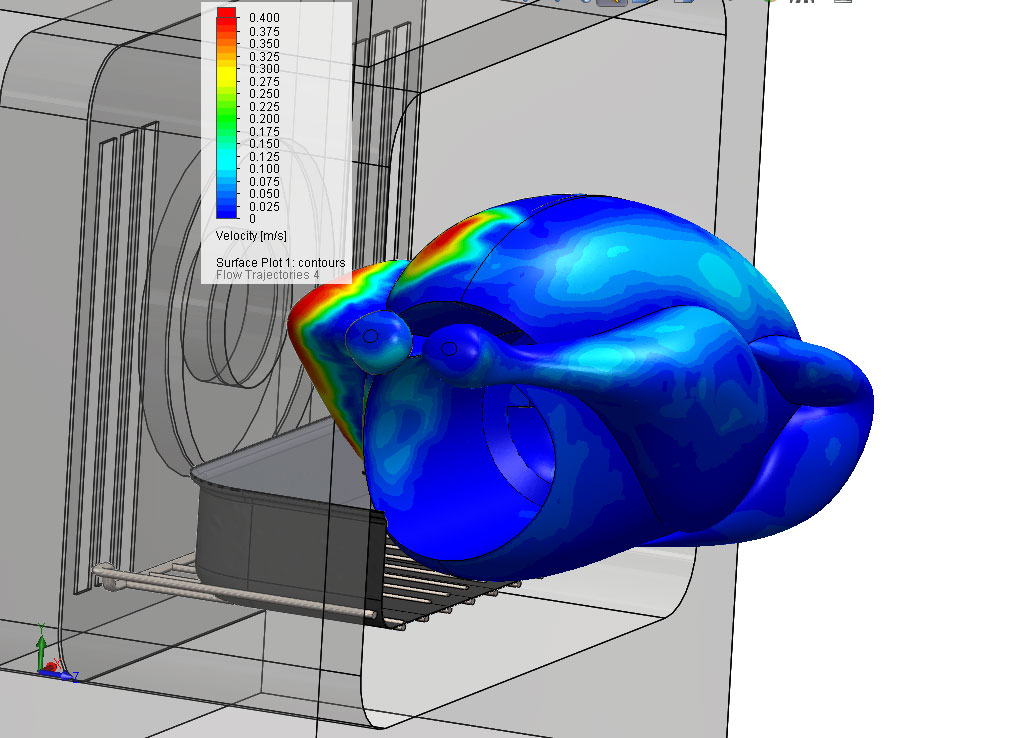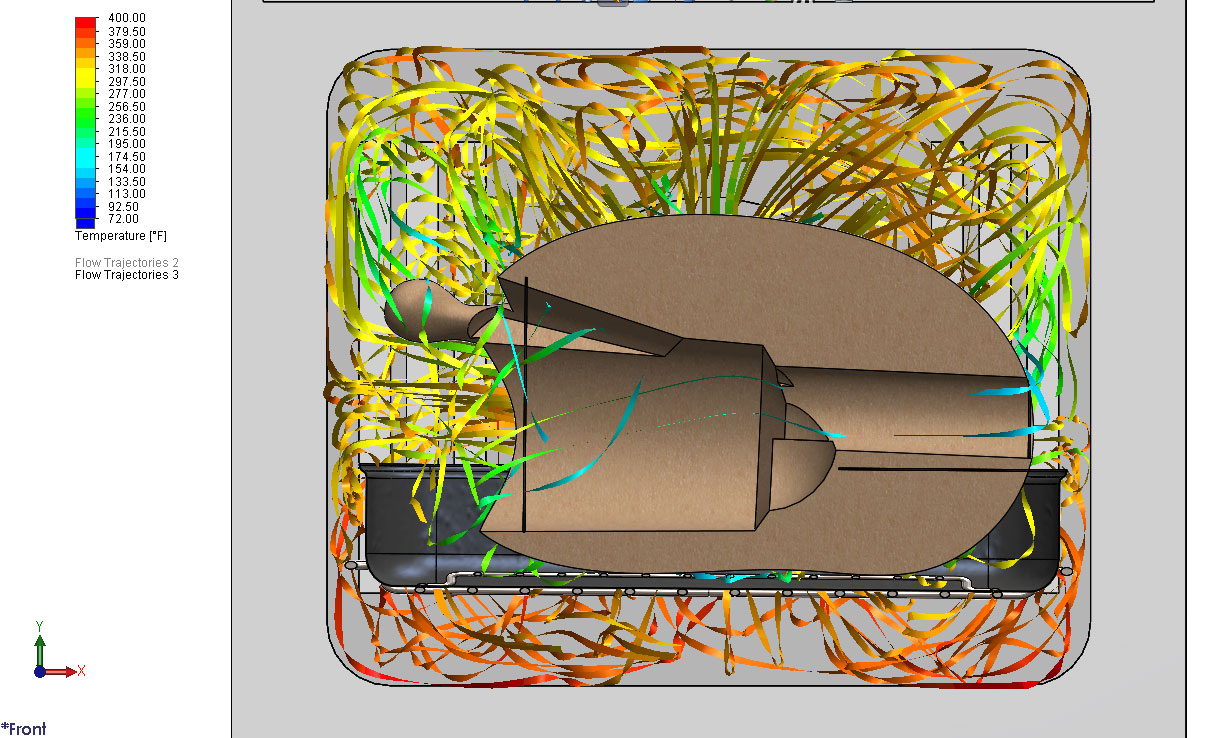Thanksgiving Throwback: How to Cook a Turkey Like an Engineer
Editor's Note: As Thanksgiving approaches, we take a long look back at one engineer's quest to cook the perfect turkey with the help of computational fluid analysis (CFD). Have a happy Thanksgiving.

Figure 8: Airspeed near the turkey surface, opposite the fan.
Latest News
November 27, 2013
By Travis Mikjaniec, Hardware Engineer, Juniper Networks; and former Application Engineer, Mechanical Analysis Division, Mentor Graphics
Editor's Note: As Thanksgiving approaches, we're happy to share one engineer's quest to cook the perfect turkey with the help of computational fluid analysis (CFD). Have a happy Thanksgiving. If you have suggestions on how you'd update this strategy, bringing it up to 2022 standards, feel free to write us at [email protected].
As the annual Thanksgiving feast approached at our house (and my wife isn’t, let’s say, experienced at cooking American food), taking the engineer’s perspective, I decided I would prefer not to have hit or miss Thanksgiving holiday dinners for the next 10 years while figuring out what is important and what isn’t when it comes to roasting a turkey. I had some empirical (experimental) results from the last two Thanksgiving dinners, but not enough to make my conclusions, so I built a computational fluid dynamics model in the Mentor Graphics FloEFD software and ran a number of airflow analyses to answer some of the questions that were plaguing me. Just exactly what is the best way to cook a large turkey, what effect does the type of oven have, and what type of rack and roasting pan produces the best results? In this article, I discuss the details of the model and my analyses, providing answers to these age-old mysterious questions once and for all.
Modeling the Turkey
The turkey model I found wasn’t quite correct because it was just one solid block. It didn’t have a cavity for stuffing or a neck cavity, so I just eyeballed those and made some cuts. I wasn’t going to buy a turkey to take measurements! Now, because one of our most important questions revolves around airflow amounts through various spaces (into the cavities, under the turkey), I created some objects so we could track this data (Figure 1). The oven was setup as a convection oven, in that there is a fan at the back pushing air horizontally over the roasting area. Lastly, the turkey was placed on a rack inside the roaster, with a height of 0.4 inches, to provide some space for air to circulate underneath the bird.
Figure 2 shows the boundary conditions for cooking the turkey. The turkey model was run as a snapshot in time, meaning I set the turkey temperature to some not-quite-fully-cooked yet temperature (120°F). The oven temperature was set to 375°F, with the heating elements being slightly hotter at 400°F at the bottom of the oven.
Once I had a good turkey model in the oven (Figure 3), the model was solved in FloEFD and I looked at some streamlines (Figure 4). Streamlines are similar to smoke streams shown in car commercials when the car is in a wind tunnel. The streamlines show where the air is going. I set the fan as the starting point of these streamlines. Although the streamlines are quite chaotic, there is still information that can be obtained for the analysis.
By sectioning the model, I could see into the roaster and into the cavity of the turkey. Compared to the streamlines outside the turkey, not a lot of air is going into the roaster and under the turkey, and even less is going through the turkey (Figure 5). But this is what I expected, especially for the cavity airflow. The fan is pushing the air across the width of the turkey, not along the length of the bird. The air would have to flow around the turkey and then make a 180 degree turn to flow into the cavity, and there is no reason for it to do so. Because turkeys are so big, they can’t be oriented in the direction of the airflow from the fan.
Calculating Airspeed
Looking at a contour plot of velocity (Figure 6), going through the middle of the turkey and oven, the airspeed through the turkey and under the turkey is very low, while the airspeed above the turkey and under the roasting pan is more significant. What constitutes very slow air? Well if we didn’t pay for a fan and had a natural convection oven, the typical airspeed for would be about 0.2 m/s. So the fan isn’t providing any improved heat transfer because the majority of the surface area of the turkey is experiencing airspeed less than 0.2 m/s.
A surface plot of the velocity near the surface of the turkey illustrates the airspeed (Figures 7, 8, and 9). I split this into three images: one shows at the turkey surface close to the fan, another image shows the opposite side, and the last shows underneath. There is a clear difference between the fan side and the opposite side, and the result is that one side of the turkey will cook much faster than the other (or dry out faster), if the turkey isn’t rotated periodically. Faster air equals faster convection, which is why we blow on soup to cool it quicker. Underneath, it’s the same as was illustrated before, that the air is not moving underneath the turkey.
Looking at temperature shown in the contour plot, the air is a lot colder inside the turkey (Figure 10). This is because the air is stagnant, that is, no hot air is making its way into the turkey. Also below the turkey, in the 0.4 inch space provided by the rack, the air temperature is cooler than the rest of the oven—again, because not a lot of fresh hot air is making its way into this space.
Why is air having a hard time making it into the space between the turkey and the roaster bottom? The streamlines in the image below show that essentially it’s the same reason that the air isn’t going into the turkey. The air coming out of the fan follows the path of least resistance. To go under the turkey, it has to travel around the wall of the roaster, down between the turkey and roaster wall, and then make a 90° turn to flow under the turkey. All the while, the air slows down, and cools down. Both are important because cold air sinks, right? And because the air speed is lower than that of a natural convection current, hot fresh air isn’t going to displace this slower, cooler air. That is why it seems like the air makes it down into the roaster, but then can’t move further under the bird and just recirculates by the roaster wall (Figure 11).
In Summary
What did I learn? Well, stuffing doesn’t impede airflow through the turkey because there is very little airflow to speak of. But the added thermal mass of stuffing inside the turkey doesn’t necessarily lead to longer cooking times and dryer turkey meat. A lot of airflow under the turkey won’t make a full crispy skin bird. A taller rack might improve this or a roaster with shallower walls, but I have my doubts. It seems to me that a rack or carrots/celery/potatoes would do the same thing: get the turkey out of the drippings. Any claim about allowing air to circulate all around the bird is false. And it’s very important to rotate the turkey so it cooks evenly.
All this thinking about Thanksgiving, and airflow analysis, makes me pretty hungry. But there are more possibilities to keep me going on this analysis, such as what would be the difference with a non-convection oven, taller rack height/roaster wall height, different roaster materials, or stuffing cooking time versus unstuffed? And what about cooking the turkey in a smoker BBQ? Clearly, much progress has been made on solving the mystery of cooking the perfect Thanksgiving turkey, but more research needs to be done.
About the Author
Travis Mikjaniec achieved his Masters Degree in Aerospace Engineering from Carleton University in 2006, with a research focus on rotorcraft aerodynamics and aeroelasticity. Travis has spent the past five years working for Mentor Graphics Corporation, Mechanical Analysis Division, specializing in the application of CFD to the design of electronics equipment. Before this, he worked for the National Research Council of Canada’s (NRC) Institute for Aerospace Research (IAR) Flight Research Laboratory in a role that focused on flight tests. Before that, he worked at the NRC's IAR Aeroacoustic and Structural Dynamics Laboratory in a role that focused on experimental testing of smart structures. Currently, Travis is a Thermal Engineer in the engineering team of the Mechanical Analysis Division, training and supporting the user base to enhance the accessibility of thermal analysis to engineering designer. Over this time, he has gained experience, not only in the use of software, but also of the general design processes and the best way to apply the CFD techniques to the real world problems encountered by engineers every day.
Subscribe to our FREE magazine, FREE email newsletters or both!
Latest News

















